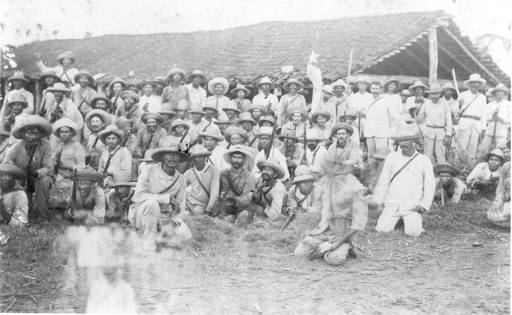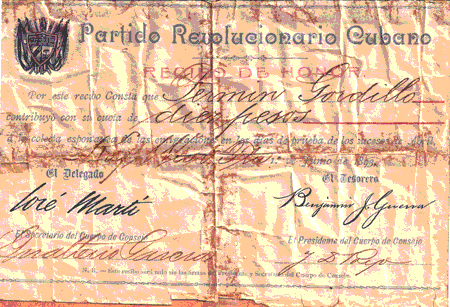|

(from the collections of the Library of Congress)
The following is a brief summary of the
three wars that Cuba fought against Spain for its freedom
 The
Ten-Years War / The Big War (1868-1878) The
Ten-Years War / The Big War (1868-1878)
The Ten Years War (also known as The Big War)
began on 10 October 1868 under the leadership of the attorney Carlos
Manuel de Céspedes and seconded by a group of patriots in the
sugar mill La Demajagua, calling for liberty and independence of
the island. During the first few days the uprising almost failed. Céspedes
attacked the small town of Yara on October 11, from which this
revolution took its name, even though the attack on Yara was a failure.
The October 10 date is commemorated in Cuba as a national holiday under
the name "Grito de Yara" ("Shout of Yara").
The Revolution of Yara extended throughout the eastern region of Cuba
and patriots gathered in several parts of the island agreed to support
Céspedes.
During the course of the Ten Years War, many atrocities were committed
by the Spanish government and by Spanish sympathizers. Among the many
repugnant incidents perpetrated during this war were:
-
The execution on 27 November 1871 of eight
medical students for allegedly scratching the tombstone of
a Spanish newspaper man.
-
The capture in international waters on 31 October 1873 and serial
execution, starting on 4 November, of 53 persons, including the captain,
most of the crew and most of the Cuban insurgents on board the steamship Virginius. The serial executions
were only stopped by the gallant intervention of a British man-of-war
under the command of Sir. Lambton Lorraine.
On 10 April 1869, a constitutional assembly took place in the town of Guáimaro in the province of Camagüey. Céspedes
was elected President of this assembly and General Ignacio Agramonte
y Loynáz and Antonio Zambrana, principal authors of
the proposed Constitution, were elected Secretaries. After completing
its work, the Assembly reconstituted itself as a Congress of Representatives,
electing Salvador Cisneros Betancourt as President of the same, Miguel Gerónimo Gutiérrez as Vice-President, and
Agramonte and Zambrana as Secretaries. Céspedes was then elected,
on 12 April 1869, as the first President of the Republic in Arms and General Manuel de Quesada (who had fought in Mexico under Benito Juárez
during the French invasion of that country), as Chief of the Armed Forces.
Ignacio Agramonte was killed by a stray bullet on 11 May 1873 and was
replaced in the command of the eastern troops by Máximo Gómez,
a general with extraordinary military skills who later led the Cuban army
in the War of Independence.
Due to political and personal disagreements, the Assembly deposed Céspedes
as President, who was replaced by Cisneros. Céspedes was later
killed in an ambush by Spanish troops on 27 Feb 1874
Activities in the Ten Years War peaked in the years 1872 and 1873, but
after the death of Agramonte and destitution of Céspedes, operations
were limited to the regions of Camagüey and Oriente, due in part
to a lack of supplies.
Tomás Estrada Palma succeeded Cisneros as President
of the Republic. Unfortunately, Estrada Palma was captured by Spanish
troops on 19 Oct 1877.
As a result of the successive misfortunes, on 8 Feb 1878 the constitutional
organisms of the Cuban government were dissolved and negotiations for
peace were started in Zanjón, Puerto Príncipe. On
10 Feb 1878, the peace terms were accepted by the Cuban and Spanish governments
and the Ten Years War came to an end, except for some subsequent protests
by a small group of followers of Antonio Maceo, who revolted in Los Mangos de Baraguá. These protests were concluded by
Maceo on 28 May 1878.
 The
Small War (1879-1880) The
Small War (1879-1880)
The manner in which the Ten Years War ended and
the political and economic consequences of the war left a great deal of
dissatisfaction among those who had bravely fought, during ten long years,
for the pursuit of liberty. This resulted in a new rebellion, in August
of 1879, fomented by several Generals of the Revolution - Calíxto
García, José Maceo (brother of Antonio) and Guillermo
Moncada, seconded by Francisco Carrillo and Emilo Núñez.
This new war started full of energy and enthusiasm,
but did not reach significant magnitude because the country wished for
peace. The Small War lasted less than a year, but was a clear indication
that the Peace of Zanjon was not the final chapter.

(courtesy of Felix Gordillo, in whose family the original has been in posession for 4 generations)
 The
War of Independence (1895-1898) The
War of Independence (1895-1898)
The War of Independence (Guerra de Independencia) started on 24
February 1895, under the intellectual leadership of the writer and
philosopher José Martí, who is considered by all
Cubans as Father of the Country. Martí gave the order to start
the Revolution on that date, which started simultaneously in four places
- in Bayate, under Bartolomé Masó; in Ibarra,
under Juan Gualberto Gómez and Antonio López Coloma;
in Baire, with the brothers Saturnino and Mariano Lora;
and in Guantánamo, with Periquito Pérez, Emilio
Giró and others. The 24 February date is commemorated in Cuba
as a national holiday under the name "Grito de Baire"
("Shout of Baire").
Unfortunately, Martí, who was eager to actively participate
in the conflict, was killed on 19 May 1895 near the town of Dos Rios in Oriente, in a skirmish with a column of Spanish soldiers under the
command of Colonel Jimenez de Sandoval.
On 13 September 1895 an Assembly formed of delegates from the five
army corps which composed the Revolutionary Army, met in Jimaguayú and elected Salvador Cisneros Betancourt as President of the
Republic, Bartolomé Masó as Vice-President, Máximo
Gómez as Commander in Chief of the Army, Antonio Maceo as Lieutenant General and Tomás Estrada Palma as diplomatic
representative in the United States.
Máximo Gómez, a brilliant military tactician, organized
several very successful campaigns, including the circular campaign around
Camagüey, and the Invasion from East to West of the entire island,
all in the short period from 8 November 1895 to 22 January 1896. The
most significant action was the victory over the Spanish General
Martínez Cámpos in the town of Coliseo.
The reaction of the Spanish Government was the replacement of Martínez
Cámpos by General Valeriano Weyler and the increase of
troops in the island which eventually numbered 180,000. Weyler forced
all inhabitants of rural areas into the cities, which had devastating
effects on the economy of the island. At the same time, yellow fever
was taking its toll of tens of thousands of Spanish soldiers in the
island. During this time, the US Senate and Congress passed separate
resolutions recognizing the Cuban Revolution.
On September 1897, a constitutional convention took place in La
Yaya, where a new government was elected. General Bartolomé
Masó was elected President and Domingo Méndez Capote Vice-President. During this year, international tensions between the
United States and Spain markedly increased. Spain finally removed General
Weyler and granted Cuba autonomy in domestic matters in 1897. These
reforms arrived too late and were not accepted by the Cuban Government
in Arms. Due to the unsettled situation, the United States Consul in
Habana, Fitzhugh Lee, advised President McKinley to send naval ships
to the ports of Cuba. Following this advice, the US battleship Maine was sent to Habana harbor. The evening of 15 February 1898, a tremendous
explosion completely destroyed the ship, killing 2 officers and 264
sailors..
On April 1898, as a result of popular opinion pressures in the US following
the explosion of the Maine, the US declared war on Spain. The US landed
troops in Cuba on 20 June 1898. After sinking the Spanish Fleet off Santiago de Cuba and several land battles in Santiago de Cuba (assisted by Cuban troops under General Calíxto García),
and also in Puerto Rico and the Philippines, Spain entered into peace
negotiations. On 16 July 1898 Spain signed a peace agreement in Santiago
de Cuba. This was followed by a formal treaty signed in Paris on 10
December 1898, putting and end to Spanish domination of Cuba. It should
be noted that the total duration of the US Spanish American War was
only 3 months.
On 1 Jan 1899 Spain formally turned over the government of Cuba to
the US. A constitutional convention met on 5 November 1900 and was followed
by elections on 31 December 1901. The US turned over the government
of Cuba to the elected Cuban government on 20 May 1902. The date
of May 20 is celebrated in Cuba as the Día de la República (Republic Day).
Ref: Carlos Marquez Sterling and Manuel Marquez Sterling - Historia
de la Isla de Cuba, La Moderna Poesia, Inc., Miami, FL. ISBN: 0-88345-251-0
|